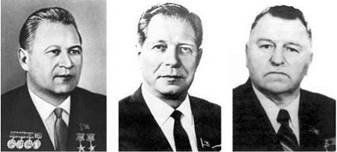CHELOMEY AND THE KREMLIN
Mishin’s TsKBEM was not the only design bureau in the USSR involved in the development of manned spacecraft. In Moscow’s eastern suburb of Reutov, 30 km south of Kaliningrad, was the headquarters of OKB-52, which in 1966 changed its name to the Central Design Bureau of Machine Building (TsKBM). It was led by Vladimir Nikolayevich Chelomey. Although there was only one letter different in the titles of the two bureaus, namely the ‘E’, Chelomey, having a staff of only 8,000
employees, had much more modest capabilities. However, because Chelomey had good relations with the military, having developed a number of cruise missiles, and because one of his engineers was the son of Nikitha Khrushchov, in the early 1960s his bureau was the main competitor to OKB-1.
In 1963 Chelomey conceived the idea to develop a military Orbital Piloted Station (OPS) equipped with cameras to monitor the US and NATO military facilities. The project was named Almaz (‘Diamond’), this name being in keeping with the practice of naming his products after precious stones. When designers from the Central Scientific-Research Institute for Machine Building (TsNIIMash) visited OKB-52 in the spring of 1964 they were shown the mockup of the station and its return capsule. It was to be launched by the powerful UR-500 Proton rocket that Chelomey was developing.[4] However, the Ministry of Defence was unwilling to finance the project. Undeterred, Chelomey sought the behind-the-scenes support of his military contacts.
In the meantime, after the assassination of John F. Kennedy, Lyndon B. Johnson became the American president. On 10 December 1963 he cancelled the US Air Force project to build a small winged ‘space plane’ named Dyna-Soar, and it was announced that plans would be drawn up for a new military space programme: the Manned Orbital Laboratory (MOL). This was to monitor the activities of Soviet military forces and observe rocket launching sites, airfields and naval bases. Since methods for rendezvousing and docking in space had yet to be developed, the plan was to launch the MOL with the crew of two military astronauts riding on top in a modified form of the Gemini spacecraft which NASA was at that time developing. The mission would last a month, and the MOL would be abandoned when the crew departed.
The capabilities of the MOL prompted the Kremlin to back Chelomey’s proposal, and the project was given to OKB-52’s Branch No. 1 at Fili, in the heart of Moscow, which had developed the Proton launch vehicle. The manager was Branch No. 1’s Chief Designer, Viktor Bugayskiy. On 12 October 1964, the day that Chelomey announced the start of work, the first Voskhod spacecraft was launched for a 1-day flight with a crew of three cosmonauts. While they were in space, Khrushchov was overthrown – and Chelomey lost his main supporter. The situation was particularly dire because, as Khrushchov’s favourite, Chelomey had gained many enemies. Not only was the new Kremlin leader, Leonid Brezhnyev, not an ally, the new Prime Minister, Aleksey Kosygin, was very rude to Chelomey during their first telephone conversation regarding the future of the UR-200 rocket programme. In fact, neither Brezhnyev nor Kosygin shared Khrushchov’s enthusiasm for manned space flights.
Another man of special importance was Dmitriy Ustinov. Since 1946 he had been responsible for the development of the Strategic Rocket Forces. He was known as ‘Uncle Mitya’ to the leaders of the design bureaus. His influence declined in the Khrushchov years, but his position was reinforced by the arrival of Brezhnyev, and in March 1965, in a major restructuring of the Soviet rocket and space programmes, he became the Secretary of the Central Committee of the Soviet Communist Party responsible for defence and space.
|
Vladimir Chelomey (left), the Secretary for Defence and Space Dmitriy Ustinov and ‘Space Minister’ Sergey Afanasyev. |
Despite the scepticism of Brezhnyev, Kosygin and Ustinov, Chelomey still had the strong support of the generals in the Soviet Air Force and the Strategic Rocket Forces. He also had the support of Mstislav Keldysh. As a long-time companion of Korolev and proponent of using rockets and satellites to facilitate scientific studies, Keldysh was one of the most eminent figures in the rocket and space programme. In fact, he had played a key role in the establishment of OKB-52 in 1955. To mark his contribution to the management of the pioneering manned space flight by cosmonaut Yuriy Gagarin in April 1961, Keldysh had been appointed President of the Soviet Academy of Sciences. In Brezhnyev’s government, the Ministry of General Machine Building was the public name for the secret rocket and space industry – the bland name was to mask the significance of its work. In March 1965, Kosygin nominated Sergey Afanasyev as the first ‘Space Minister’. On 25 August 1965 President Johnson gave the formal go-ahead for the MOL project, which was to make its first flight by the end of 1968. Two months later, on 27 October, Afanasyev signed the order for Almaz. The preliminary paperwork was drawn up in 1966 and, based on regulations signed by the Council of Ministers and the Central Committee of the Soviet Communist Party, on 14 August 1967 the technical requirements and timescale were specified.











